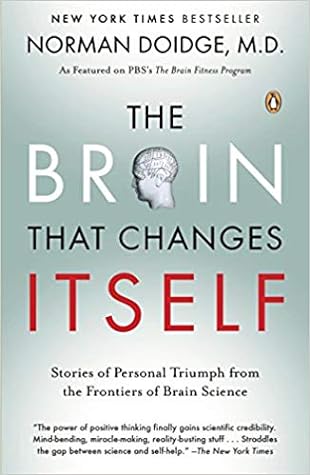More on this book
Community
Kindle Notes & Highlights
Read between
January 21 - February 8, 2022
The mental “tracks” that get laid down can lead to habits, good or bad. If we develop poor posture, it becomes hard to correct. If we develop good habits, they too become solidified. Is it possible, once “tracks” or neural pathways have been laid down, to get out of those paths and onto different ones? Yes, according to Pascual-Leone, but it is difficult because, once we have created these tracks, they become “really speedy” and very efficient at guiding the sled down the hill. To take a different path becomes increasingly difficult. A roadblock of some kind is necessary to help us change
...more
Pascual-Leone discovered, as Taub had, that to develop a new pathway, you have to block or constrain its competitor, which is often the most commonly used pathway.
What it implies is that people learning a new skill can recruit operators devoted to other activities, vastly increasing their processing power, provided they can create a roadblock between the operator they need and its usual function.
Then in the 1980s Fernando Nottebohm, a bird specialist, was struck by the fact that songbirds sing new songs each season. He examined their brains and found that every year, during the season when the birds do the most singing, they grow new brain cells in the area of the brain responsible for song learning.
Gage’s colleague Gerd Kempermann raised aging mice in enriched environments, filled with mice toys such as balls, tubes, and running wheels, for only forty-five days. When Kempermann sacrificed the mice and examined their brains, he found they had a 15 percent increase in the volume of their hippocampi and forty thousand new neurons, also a 15 percent increase, compared with mice raised in standard cages.
in order to keep the brain fit, we must learn something new, rather than simply replaying already-mastered skills. But as we’ve said, there is a second way to increase the number of neurons in the hippocampus: by extending the life of neurons already there. Studying the mice, the team found that learning how to use the other toys, balls, and tubes didn’t make new neurons, but it did cause the new neurons in the area to live longer.
We now know that exercise and mental activity in animals generate and sustain more brain cells, and we have many studies confirming that humans who lead mentally active lives have better brain function. The more education we have, the more socially and physically active we are, and the more we participate in mentally stimulating activities, the less likely we are to get Alzheimer’s disease or dementia.
Physical activity is helpful not only because it creates new neurons but because the mind is based in the brain, and the brain needs oxygen. Walking, cycling, or cardiovascular exercise strengthens the heart and the blood vessels that supply the brain and helps people who engage in these activities feel mentally sharper—as pointed out by the Roman philosopher Seneca two thousand years ago.
Nothing speeds brain atrophy more than being immobilized in the same environment; the monotony undermines our dopamine and attentional systems crucial to maintaining brain plasticity.
Vaillant concluded that old age is not simply a process of decline and decay, as many younger people think. Older people often develop new skills and are often wiser and more socially adept than they were as younger adults. These elderly people are actually less prone to depression than younger people and usually do not suffer from incapacitating disease until they get their final illness.
Mary Fasano, at age eighty-nine, earned her undergraduate degree from Harvard. David Ben-Gurion, the first prime minister of Israel, taught himself ancient Greek in old age to master the classics in the original. We might think, “What for? Who am I fooling? I’m at the end of the road.” But that thinking is a self-fulfilling prophecy, which hastens the mental decline of the use-it-or-lose-it brain. At ninety, the architect Frank Lloyd Wright designed the Guggenheim Museum. At seventy-eight, Benjamin Franklin invented bifocal spectacles. In studies of creativity, H. C. Lehman and Dean Keith
...more


